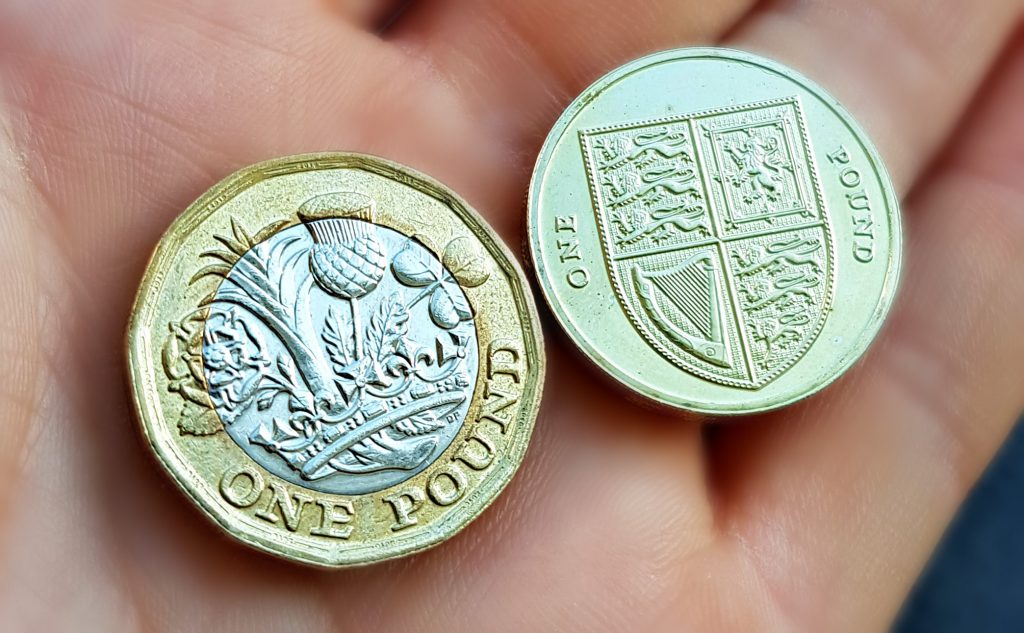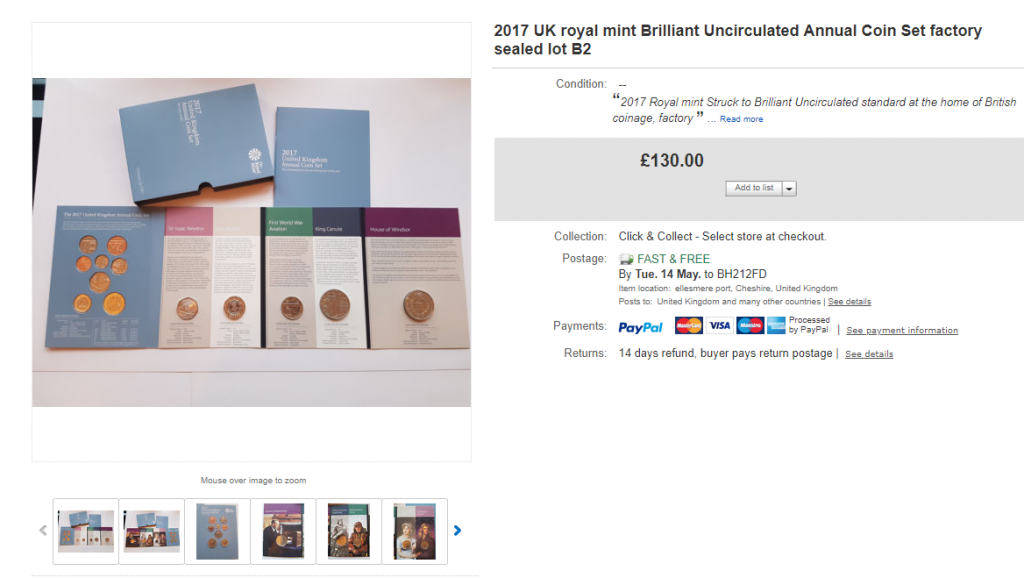Mintages
Why you won’t find any 2017 20p coins in your change…
For those of you collecting date runs, you might have noticed that in 2017 The Royal Mint didn’t strike a single £2 or 20p coin for general circulation.
In 2016, nearly 29 million £2 coins and almost 213 million 20p coins were struck for circulation, however the next year that number dropped to 0.

From the graph above, you’ll notice that whilst most denominations had relatively few coins struck in 2017 compared to 2016, the mintage figure for £1 coins for both years is comparatively very high.
Introduction of the new £1
It’s thought that the introduction of the new 12 sided £1 coin to replace the old round pound in 2017 affected the demand for the other coins in circulation.

This could be down to the fact that the public were emptying their piggy banks and checking their loose change to make sure their old pound coins were used up before shops stopped accepting them. In doing so, they also ended up spending other coins in their change, meaning there was plenty of cash to re-circulate, and not as much demand for new coins to be struck for circulation.
This coupled with the growth of card payments and the decline of cash transactions, as well as the impressive 25-30 year lifespan of UK coins meant that enough £2 and 20p coins could be re-circulated in 2017 and new coins weren’t needed.
The Royal Mint had been expecting this drop in demand, as had been seen in similar cases overseas when coins were withdrawn.
Where does demand for cash come from?
The Royal Mint does not actually have any real control over how and when coins go into circulation, as this is based on demand.
HM Treasury and the large cash distribution services run by the Post Office and some banks, as well as private operators handle, sort and distribute the billions of coins in circulation, even swapping stocks between themselves.
The Royal Mint and cash distribution services regularly review the amount of coins in circulation and it’s only when they are short of a particular denomination that stocks will be called from The Royal Mint, who act as the manufacturer of the coin on behalf of the Treasury.
Surplus coins will be re-circulated before new coins are released.
Rare 50p coins from 2017
Whilst more 50p coins were struck in 2017 than 2016, two 2017 designs in particular actually have some of the lowest mintage figures of any 50p coins in circulation, excluding the Olympic 50p series.
The 2017 Royal Shield actually comes in as the second rarest 50p in circulation, closely followed by the 2017 Sir Isaac Newton 50p.
Take a look at our 50p and £2 mintage charts here.

Where can I find the 2017 £2 and 20p coins?
Whilst no £2 or 20p coins were issued for circulation in 2017, brilliant uncirculated commemorative coins were still issued, including the Jane Austen and First World War Aviation £2 coins.
These coins, along with the 2017 Britannia £2 and the 2017 20p which weren’t issued for circulation were also featured in brilliant uncirculated quality within the 2017 Annual Coin Set, which has now sold out at The Royal Mint.
This means that the only way to get hold of these coins is to purchase the set on the secondary market, with prices typically around £65, although some sets have sold for over £100.

So far the 2018 £2 coins haven’t been released into circulation and whilst the 2019 Royal Shield 50p has been seen in circulation, we’re yet to hear if any of the other 2019 coins will turn up in our change.
Do you think the move towards a cashless society could be on the horizon, or are we still recovering from the surplus cash flow in 2017? Let us know in the comments below!
Secure the commemorative coins from 2017 for your collection!
Today you can own all 4 of the United Kingdom’s commemorative coins from 2017 with the Change Checker Commemorative Coin Pack, including the rare Sir Isaac Newton 50p and the Jane Austen and First World War Aviation £2 coins that can’t be found in circulation.
The 50p that’s even rarer than the 2017 Isaac Newton coin…
In 2008, Matthew Dent redesigned the UK’s definitive coins following a public competition which saw over 4,000 designs submitted.
His Royal Shield of Arms design was chosen by The Royal Mint Advisory Committee to feature on the reverse of all UK coins, and when each coin from the penny to the 50p is placed together, the completed design reveals the full shield. The lower section of the shield can be seen on the reverse design of the UK 50p.

Definitive 50ps are usually issued into circulation every year and generally go unnoticed as they are so readily available and mintage figures are often in the high millions.
Since 2008 this coin has been issued into circulation six times, but which Royal Shield 50p is the rarest?

The Royal Mint only issues coins based on demand, and therefore the coin wasn’t issued for circulation in 2009, 2010, 2011 or 2016. In the years that the coin was issued, the mintage figures vary from just 1,800,000 all the way up to 49,001,000.
By far the rarest 50p shield is the 2017 coin, which is actually the second rarest 50p coin in circulation!
The Kew Gardens is known as the UK’s rarest circulation 50p, with a mintage of just 210,000 and the next rarest commemorative 50p is the 2017 Sir Isaac Newton, with a mintage of 1,801,500. However, when you include definitive coins into the mix, the 2017 Royal Shield actually knocks the Sir Isaac Newton off second spot, with 1,500 less coins issued.

The most common Royal Shield 50p is the 2014 coin, with a mintage of 49,001,000, although this is not the most common 50p in circulation…
That title goes to the old definitive, featuring Christopher Ironside’s Britannia design. This design was first issued in 1969 as the first seven sided coin, issued to replace the 10 shilling note.

New Pence Britannia 50p. Issued from 1969 to 1981
In 1997 the coin was made smaller and lighter and the old coins ceased to be legal tender in the UK. Therefore, a whopping 456,364,100 Britannia 50p coins were issued that year to replace the old design, making the 1997 Britannia 50p Britain’s most common 50p.
Are the definitive 50p coins worth collecting?
As collectors, we often focus on the rarer commemorative designs when it comes to building our collections, but I think the chart above just goes to show why we shouldn’t overlook the rarity of the definitive coins.
You’re very likely to come across the Royal Shield 50p in your change (in fact, there might be one in your pocket right now!) so make sure you keep your eyes peeled to see if you can find the rare 2017 coin for your collection!
Own the UK’s rarest Royal Shield 50p within the 2017 Royal Mint Pack!
This set is no longer available from The Royal Mint, but today you can own all 13 of the United Kingdom’s 2017 annual coins in the Royal Mint Brilliant Uncirculated pack, including the UK’s rarest Royal Shield 50p.
The rarest 50p and £2 coins revealed! UPDATED UK mintage figures.
As collectors, we often find ourselves focusing on the commemorative coins that turn up in our change, but how often do we pay attention to the definitive designs?
We wouldn’t normally combine definitive and commemorative mintage figures into one chart, however the comparative figures give us an interesting insight into the change in our pockets and actually go to show why the definitive coin designs deserve your attention…
50p Mintage Figures
Our latest charts featuring the updated commemorative coin mintage figures for circulation coins revealed the 2017 Sir Isaac Newton 50p as the second rarest UK 50p in circulation after the Kew Gardens, with a mintage of just 1,801,500. This knocked Jemima Puddle Duck off the second spot with a whopping 298,500 less coins being struck.
Change Checkers had already shown a great response to the Sir Isaac Newton coin, voting it their favourite coin design of the year in 2017. But now, as we delve deeper into the mintage figures for not only commemorative 50p coins but also the definitive designs, an unlikely rival has pipped the 2017 Isaac Newton to the post to claim the title of the second rarest UK 50p coin in circulation…

You might be surprised by the second rarest 50p in circulation…
The chart above features the mintage figures for every commemorative and definitive UK 50p coin in circulation and whilst the Kew Gardens still remains king, it came as a surprise that the second rarest 50p was actually a definitive rather than a commemorative design.
The 2017 Royal Shield 50p has a mintage of just 1,800,000 which means there are 1,500 less coins than the 2017 Sir Isaac Newton 50p. This is by far the lowest mintage figure for any definitive 50p coin, with the next rarest definitive coin having almost double the amount of coins struck – the 2008 Britannia with a mintage of 3,500,000.
Definitive 50p coin designs
Christopher Ironside’s Britannia design featured on all UK definitive coins from their first appearance in 1969 with the words ‘NEW PENCE’ inscribed above. The inscription was revised in 1982 to say ‘FIFTY PENCE’ and this design remained unchanged until 2008, when Matthew Dent’s Royal Shield design was introduced, featuring the third and fourth quarters of the Royal Arms.

It comes as no surprise that the majority of the definitive designs can be found towards the bottom of the chart, with the most common UK 50p in circulation being the 1997 Britannia. The old larger 50p and this smaller one were both dated 1997, however the larger coin was only struck as year sets, whereas the smaller circulated in very large numbers, with a mintage of 456,364,100.
The fact that the 2017 Benjamin Bunny commemorative 50p features in amongst the definitive designs goes to show just how many of this design were struck and how likely you’ll be to find one in your change.
We haven’t included the Olympic 50p coins in the mintage chart as this was a specially struck series, with low mintages figures for each coin. You can see the Olympic 50p mintage figures here >>
£2 Mintage Figures
When it comes to the £2 coins, the Commonwealth Games are some of the rarest in circulation. In fact, all four coins would be sat at the top of the mintage charts if it wasn’t for two 2015 coins…

The rarest definitive £2 coin revealed…
Many collectors will be aware of the 2015 Navy £2‘s low mintage figure of 650,000, making it the third rarest UK £2 coin in circulation, however many of us may not know that this coin is in fact joint third, as a definitive design from the same year also holds the same low mintage figure.
In 2015, the new definitive £2 coin was introduced, with a design featuring the Britannia, replacing the Technology design which had featured on the coin since 1997. Britannia has featured on a British coin in one way or another for more than 300 years, apart from after 2008 when she was dropped from the 50p coin. She received a welcome return to British coinage for the 2015 definitive £2, but with so few coins being struck, this coin has become the third rarest UK £2 coin in circulation.
The 2016 version of the coin had a higher mintage of 2,925,000, but this is still incredibly low when compared to the 1998 Technology £2, which has a mintage of 91,110,375.

Of course the most common £2 coin you’re likely to come across in your change is the Technology £2, which dominates the bottom of the chart. The rarest of the Technology £2 coins is actually the 2005 issue, with a mintage of 3,837,250, making it the eighteenth rarest UK £2 in circulation.
You may have noticed a lack of 2017 coins on the £2 chart as to date The Royal Mint haven’t confirmed if they will enter circulation. Based on The Royal Mint’s figures, we know that no 2017 Britannia coins were struck for circulation.
I was certainly surprised by the rarity of some of the definitive designs shown on the charts above and will be checking the dates of the coins in my change very carefully to see if I can find any rarer ones for myself, but will you be doing the same?
Your chance to own the 2017 Britannia £2
This coin wasn’t struck for circulation, however you can own this coin as part of the 2017 Royal Mint Annual set.
But you’ll have to be quick, as this set is no longer on sale at The Royal Mint.



